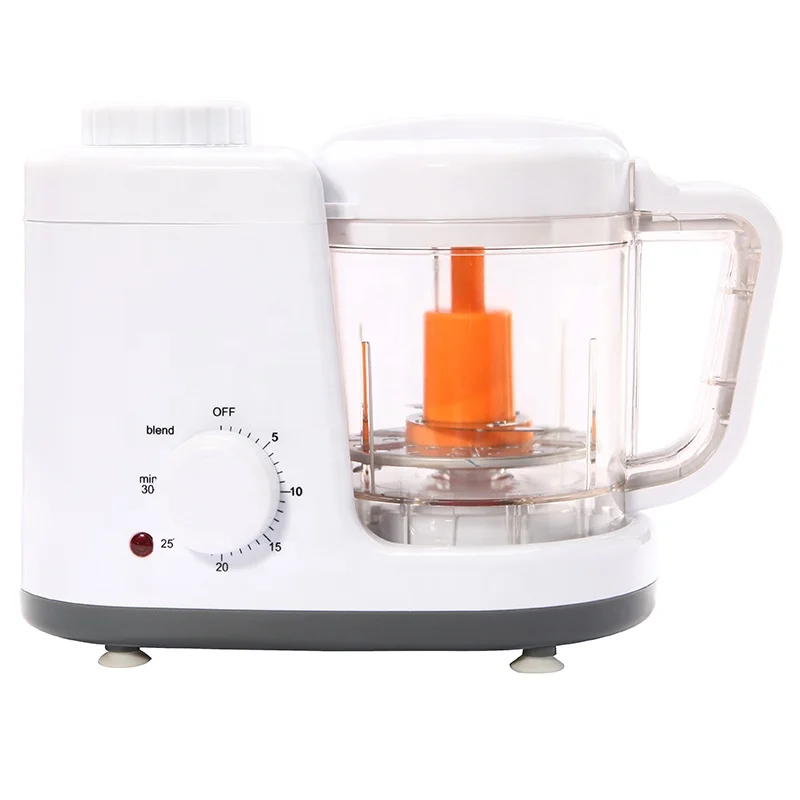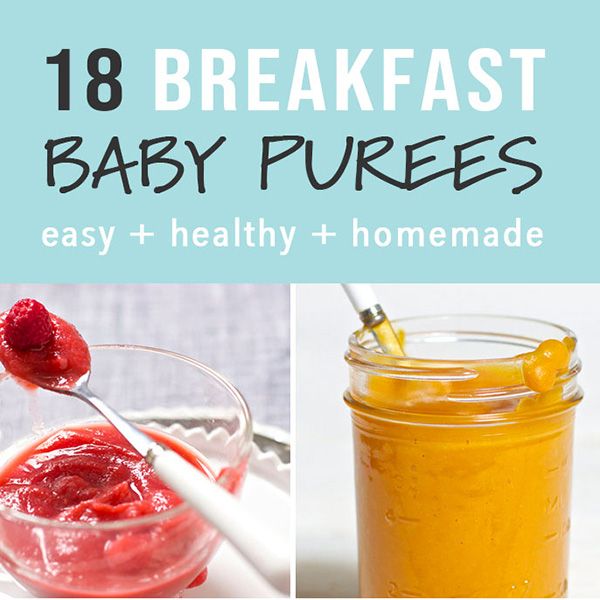Baby food maker steam and blend
The Best Baby Food Makers Make Life Easier
The best baby food makers make it simple to whip up homemade, high-quality food for your little one. Sometime between four and six months old, your baby will make the exciting—sometimes nerve wracking—transition from subsisting solely on breastmilk and/or formula to eating solid foods. Navigating baby food can be intimidating for the best of us: Should you make purées or do baby-led weaning? What should your baby’s very first food be? And do you really need a baby food maker?
While you can certainly get by without one, baby food makers make life a little easier—and for new parents, anything that makes life a little easier is worth its weight in gold. Many makers multitask, so you can also steam veggies for your toddler or make a smoothie for your own breakfast. Investing in a baby food maker means you know exactly what your baby is eating, you can save money over time, and you can get meals on the table (er, highchair, and possibly the floor) quickly and easily. Here are the very best baby food makers.
- Best Overall: Beaba Babycook Solo
- Blender: Bamix Immersion Blender
- Puree Maker: Breville Mini Wizz
- Grinder: OXO Good Grips Food Mill
- Smoothies: Grownsy Baby Food Maker
- Steamer: Baby Brezza One Step Homemade Baby Food Maker Deluxe
- Masher: OXO Tot Food Masher
Beaba Babycook Solo
SHOP NOW
7"D x 9"W x 9.5"H | 4 pounds | plastic
- Works as a steamer, blender, warmer and defroster in one
- Easy to clean and store
- Fast - makes food in 15 minutes or less
- Auto shut-off cooking timer means there’s no need to watch over the machine
- Pricey
- Must descale with vinegar occasionally to get rid of mineral deposits (true for any steamer)
Why we chose it: This awesome appliance steams, blends, defrosts, and reheats fruits, veggies, fish, and meat, making it the ideal one-and-done baby food champion.
That means you can put in raw meat and come out with perfectly cooked and pureed food for your baby without getting any pots, pans or blenders dirty. Plus, it’s intuitive to use. “It's easy to use, virtually mold-proof, and cooks and reheats in under 15 minutes,” says Christen Costa, CEO of Gadget Review. “It also has built-in blending capabilities which make it a perfect all-in-one baby food maker.” Its compact design is great for small spaces, and it’s truly easy to clean. Bonus: its ergonomic one-handed design means you can hold your baby in one hand and prep organic baby food with the other, like the super parent you are.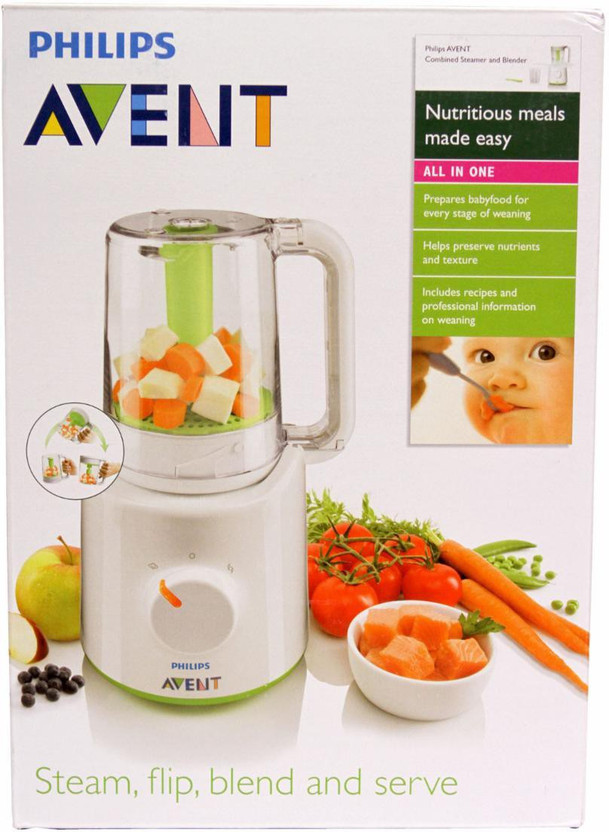
Blender
SHOP NOW
4.8 x 2.8 x 14.4 inches | 2.6 pounds | Metal
- Highly durable, with two-year warranty
- The AC motor keeps a constant, precise speed under heavy loads
- Relatively small and easy to store
- Stainless steel blades can blend almost anything with ease
- Only one function - no steaming, etc.
- Expensive
Why we chose it: “A baby food maker can be a good choice for preparing baby food, but it has limited use,” says Colleen Colodany, CEO of kidswiki.co.uk, a website that reviews kids’ products.
“Instead of buying a baby food maker, an immersion blender would do the job just as well. It has diverse use in the kitchen and does multiple things.” She recommends the Bamix Immersion Blender for its small size, ease of use, and durability. Plus when the baby has moved onto eating like a toddler (hi mac and cheese!), you’ll have a well-made kitchen tool on hand.
This blender will become a favorite in your kitchen, for making baby food and beyond. It’s built by hand in Switzerland, and Bamix has been making excellent appliances since 1954. Found in the kitchens of professional chefs, it has three interchangeable blades and offers both power and precision, making quick work of puréeing baby food. You can purée soups, turn frozen fruit into sorbet, and whip milk into cream after your baby has enjoyed their pear purée, and when you’re all finished, it’s easy to clean thoroughly with water.
Puree Maker: Breville Mini WizzPuree Maker
SHOP NOW
18. 5 x 14 x 22.5 cm | 250 watts | 1.5 kg | stainless steel
5 x 14 x 22.5 cm | 250 watts | 1.5 kg | stainless steel
- One-year replacement warranty
- Useful for baby food and beyond
- Attractive design, easy to clean and store
- Only one function - no steaming, etc.
- Too small to make big batches
Why we chose it: Whether you’re turning basil and garlic into silky pesto or steamed sweet potatoes into baby food, Breville's Mini Wizz will easily and efficiently do the trick.
With its compact frame, it’s friendly to kitchens where space is in short supply. It’s also refreshingly easy to use, with ergonomic design and simple controls. The lid has two small holes in the indents on top so that you can easily add liquid ingredients as you prepare food for your family. This little food processor is well designed, easy to clean, and a great size when you only need to feed a very little human.
This little food processor is well designed, easy to clean, and a great size when you only need to feed a very little human.
Grinder
SHOP NOW
14.75 x 7.25 x 10.25 inches | 2.29 pounds
- Can wash all parts in the dishwasher
- Silicone coating for comfortable grip
- Can make applesauce, marinara, and more for the whole family
- Only a grinder - will have to cook food separately
Why we chose it: Low tech can be a positive thing. The OXO Good Grips Food Mill is a smart choice if you’re ok with a manual option for processing food into smooth purées.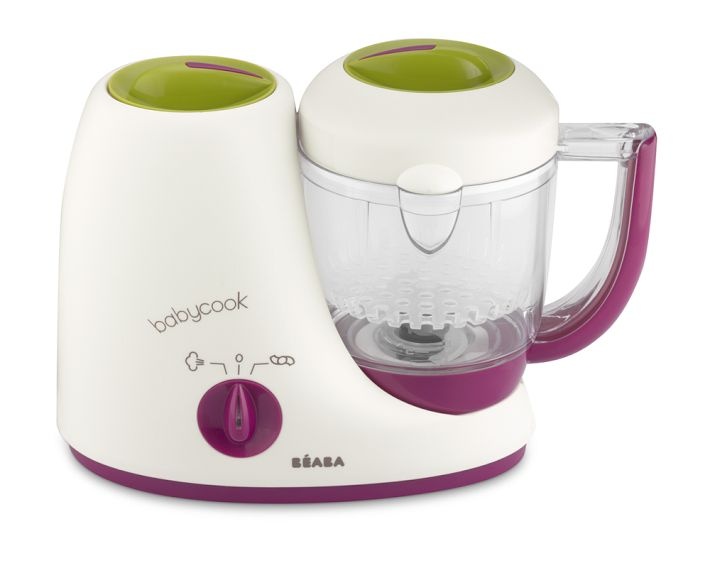
It includes three grinding discs for fine, medium, and coarse textures, and the stainless steel inner bowl won’t stain even when you’re dealing with messy foods like beets or carrots. It’s easy to exchange discs and disassemble, and its legs fold for easy storage.
Smoothies: Grownsy Baby Food MakerSmoothies
SHOP NOW
0.5"D x 2"W x 2"H | 4.11 pounds
- See-through design means you can watch food being made
- Warming function means you can put a bottle in the water tank to warm the milk
- Large container can accommodate a week’s worth of baby food
- Multi-function and easy to use
- Takes up a relatively large amount of counter space
Why we chose it: This steamer, grinder, and blender is incredibly multi-functional—the Grownsy Baby Food Maker monitors and maintains food temperature as well.
It’s also incredibly easy to use for sleep deprived parents: you can control the speed of its four precision blades with a handy LCD touch screen panel. It can also heat milk, keep things warm, and even self-sterilize. It’s great for smoothies as the special blade design makes it easy to turn fresh and frozen fruits into a silky-smooth consistency. Pour a satisfying smoothie for your baby, and make one for yourself while you’re at it.
Steamer: Baby Brezza One Step Homemade Baby Food Maker DeluxeSteamer
SHOP NOW
- Easy to use and clean
- Comes with three reusable food pouches and filling funnels
- Takes about 10 minutes to make 3.5 cups of baby food - fast!
- Relatively expensive
Why we chose it: This all-in-one baby food maker has plenty of useful features.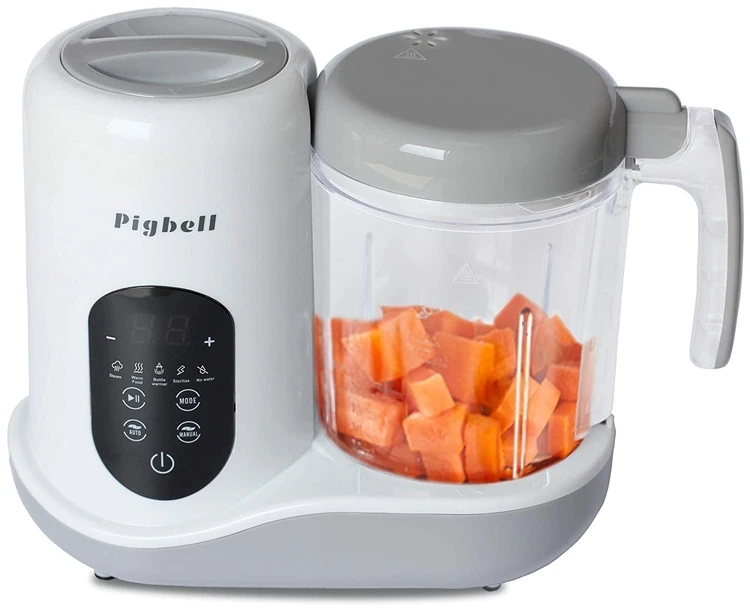
Its one-button option for steaming and blending lets you add water and food and come out with freshly steamed and puréed fruits and veggies in about 10 minutes. If you only want to steam or blend, you can do that, too. It’s an especially great steamer as its steam tank is fully accessible for easy cleaning, and it’s fast, reliable, and easy to use. It’s also great for non-baby foods: you can use it to steam pasta and vegetables, make hard boiled eggs or even soup.
Masher: OXO Tot Food MasherMasher
SHOP NOW
4.5" L x 7.1" W x 8.1" H | .42 pounds
- Super affordable
- Lifetime manufacturer's warranty
- Compact and easy to store
- Only one very specific use
Why we chose it: For those who aren’t into fancy baby food makers, this product is genius in its simplicity.
Turn tender foods like avocado, bananas, and berries into mushy goodness perfect for babies eating (and smearing everywhere, as babies love to do). Steep sides prevent food from slipping out of the bowl while you’re using it, and teeth help scoop food out when it’s ready for serving so you won’t waste food. The already compact masher collapses into two parts for easy portability, and a 360 lid can be snapped shut in multiple positions, making it easy to handle.
Things to Consider Before Buying a Baby Food MakerCapabilitiesSome baby food makers will steam, blend and purée, while others simply grind or blend your food. Decide which functions are important to you, and how much you want to invest, as the makers with more capabilities tend to have a higher price tag.
Your kitchen is probably already taken over by baby bottles, just as your home is taken over by baby stuff. Decide how much counter space you’d like to devote to making baby food, keeping in mind that it will be for a specific period of time.
“A baby food maker is definitely worth the investment if you want to be 100% certain of all of the ingredients in your little one's meals,” says Costa. Making your own food also means you can introduce your little ones to your family’s favorite dishes, instead of being limited to the store-bought foods on offer. Another bonus: prepping your own baby food lets you figure out the perfect portion for your baby in advance, and even freeze any leftovers.
What is the difference between a baby food maker and a food processor?Top-of-the-line baby food makers often include a steamer and a blender or food processor in a single appliance. In contrast, a regular food processor can make purée, but you’ll need to cook or steam the food separately. You can absolutely use a food processor to prepare baby food.
What are the healthiest baby foods?Just like for adults, there’s no single healthiest food for babies. A healthy strategy is to intoduce your baby to a variety of flavors and foods. Many experts recommend starting with single foods or ingredients, like puréed squash, applesauce, mashed bananas, avocado, puréed peaches, puréed meats, and iron-enriched baby cereal like oatmeal. Your baby might start with puréed or semi-liquid foods, then graduate to strained food, and then start experimenting with finger foods. You can gradually introduce new ingredients and foods to your baby as they become more and more comfortable eating. Always consult your pediatrician before beginning solids.
A healthy strategy is to intoduce your baby to a variety of flavors and foods. Many experts recommend starting with single foods or ingredients, like puréed squash, applesauce, mashed bananas, avocado, puréed peaches, puréed meats, and iron-enriched baby cereal like oatmeal. Your baby might start with puréed or semi-liquid foods, then graduate to strained food, and then start experimenting with finger foods. You can gradually introduce new ingredients and foods to your baby as they become more and more comfortable eating. Always consult your pediatrician before beginning solids.
Plastic is a durable, highly safe option if your product is free from BPA and phthalates.
Final thoughtsDepending on your budget and needs, the best baby food maker will take a lot of stress out of feeding your little one. Whether you want a 4-in-1 ninja that does it all or simply an immersion blender that can double as a tool to whip up creamy soups for the whole family, we have you covered.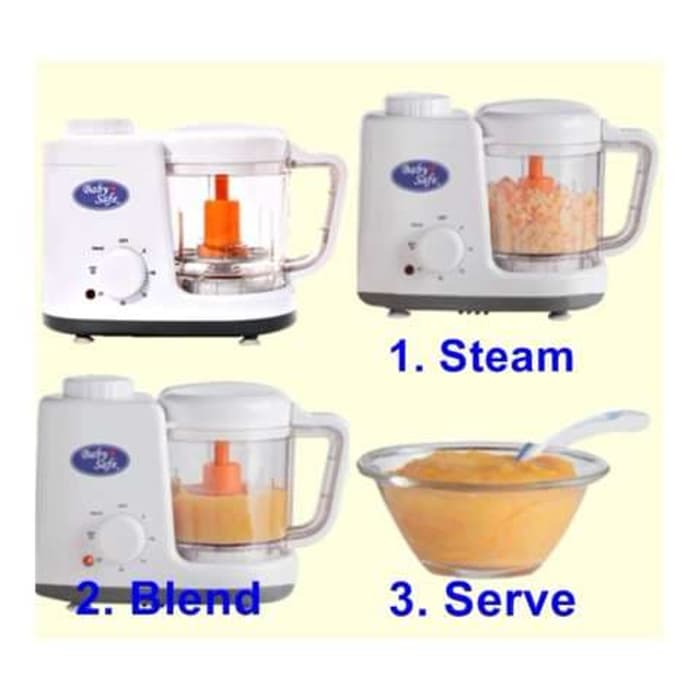
As a food writer and the mother of a toddler and a baby, I’ve spent a lot of time feeding babies and thinking about the best way to make this sometimes thankless task quick and easy.
I surveyed fellow parents, friends, and family to see what baby food makers they swore by, then reached out to reputable sources to get their wisdom. I also read reviews from across the web and scoured Amazon reviews, too. Since babies only need specific food for a short window of time, value was an extremely important factor in putting together this list. Since parenting a baby is an exhausting endeavor, I nixed anything too complicated. The best baby food makers bring some ease into the day; there’s no room for anything that adds frustration in a parent’s life, period.
Every product is independently selected and vetted by editors. Things you buy through our links may earn us a commission.
5 Best Baby Food Makers, Mashers, and Mills of 2022
Written by Jessica Booth
Updated September 20, 2022
While there’s nothing wrong with store-bought baby food, it’s hard to ignore the advantages of homemade baby food. It’s also hard to ignore how intimidating this can seem. Cooking up batches of your own baby food can seem like a frustrating, time-consuming experience, but the truth is that the right gear can make a huge difference. In the over-saturated market of baby essentials, it can be difficult to find the food maker that’s right for your family. To help you decide, we spent days researching and testing the most popular models, pureeing up six different fruits and vegetables any growing baby would love.
It’s also hard to ignore how intimidating this can seem. Cooking up batches of your own baby food can seem like a frustrating, time-consuming experience, but the truth is that the right gear can make a huge difference. In the over-saturated market of baby essentials, it can be difficult to find the food maker that’s right for your family. To help you decide, we spent days researching and testing the most popular models, pureeing up six different fruits and vegetables any growing baby would love.
While there were plenty of great options, the Beaba Babycook 4-in-1 (available at Amazon) is our clear favorite. A convenient space-saver, it can steam cook and puree with ease. For a less expensive option, the NutriBullet Baby (available at Amazon) doesn't offer steaming capabilities, but its ease of use and included storage containers earned it our pick for best value.
Editor's Note
The recommendations in this guide are based on thorough product and market research by our team of expert product reviewers.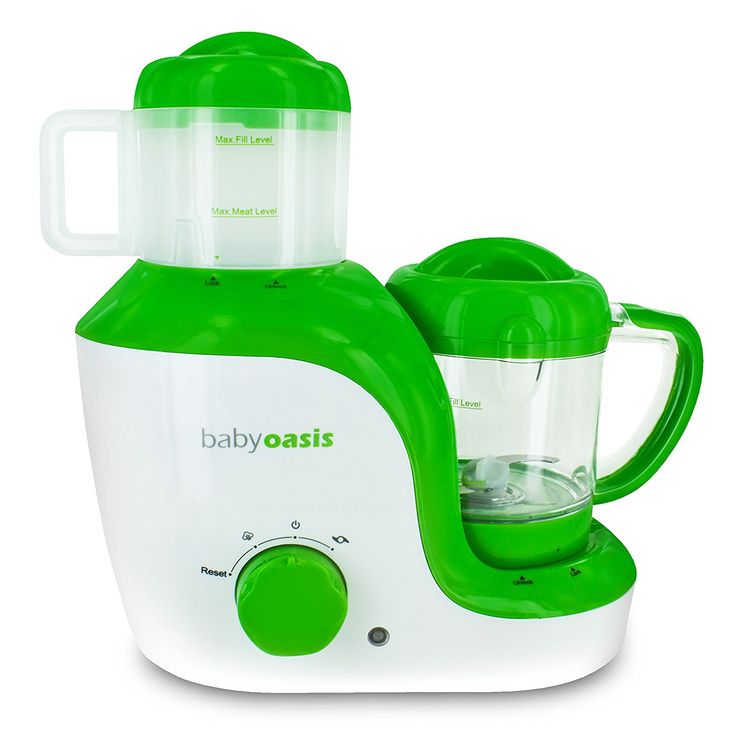 The picks are based on examining user reviews, product specifications, and, in some limited cases, our experience with the specific products named.
The picks are based on examining user reviews, product specifications, and, in some limited cases, our experience with the specific products named.
Credit: Beaba
The Beaba is an all-in-one steamer and blender that makes consistently smooth purees.
Best Overall
Beaba Babycook
The Beaba Babycook 4-in-1 is a compact all-in-one option that both steams and purees your food. It features a straightforward design that makes it very easy to use and was by far the quietest of the bunch when it came to the blending portion of the food making. It steams in minutes, and with a touch of a button, creates smooth and creamy purees in under one minute. You’re able to easily control the amount of water that goes into making your purees, which is a nice plus. You don’t need to figure out how much time to use, either—just add the correct amount of water, press the steam button, and it figures it out for you and alerts you when it’s done.
The Beaba is very easy to clean and most of the parts are dishwasher safe, although I will say that the biggest con for me is that you can’t see inside the water tank, which makes it pretty impossible to check if there's mold or bacteria growing inside.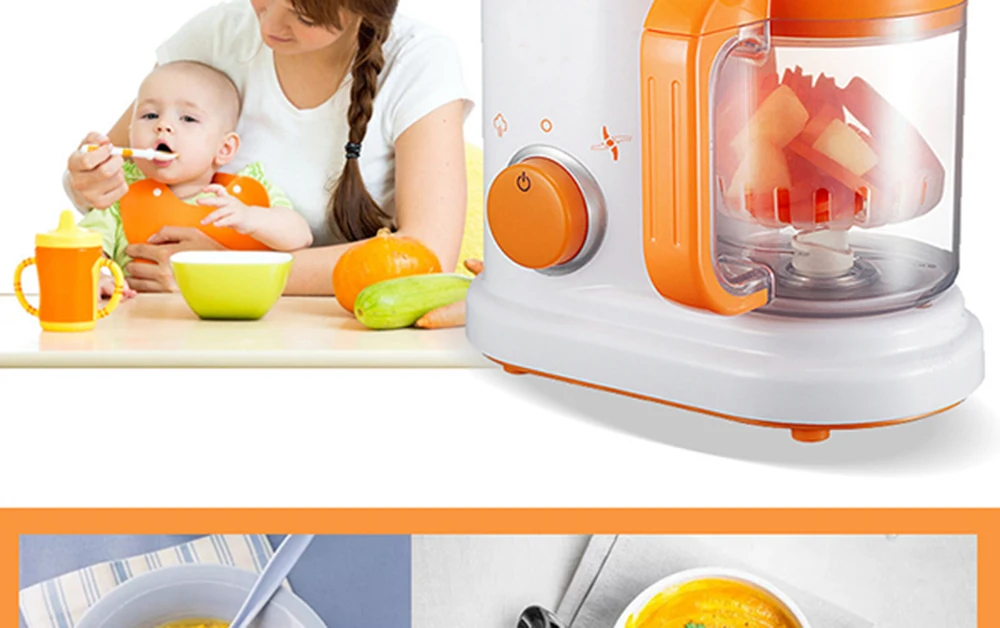 You can clean this out with a white vinegar descaling method, but still: I would feel more comfortable if I could get a glimpse inside. I found the manual to be almost too vague, although with a close look I was able to figure everything out pretty quickly. And while the steam basket isn’t quite as large as some other models, it makes a sufficient amount of food. I also love the aesthetics here: the Babycook is offered in a few different colors, like a rose gold model with gold touches that look surprisingly chic for a baby food blender. All in all, it makes excellent purees and doesn’t compromise on style, so it was hard to beat.
You can clean this out with a white vinegar descaling method, but still: I would feel more comfortable if I could get a glimpse inside. I found the manual to be almost too vague, although with a close look I was able to figure everything out pretty quickly. And while the steam basket isn’t quite as large as some other models, it makes a sufficient amount of food. I also love the aesthetics here: the Babycook is offered in a few different colors, like a rose gold model with gold touches that look surprisingly chic for a baby food blender. All in all, it makes excellent purees and doesn’t compromise on style, so it was hard to beat.
Credit: Reviewed / Betsey Goldwasser
The Baby Bullet produces smooth purees and is reasonably priced.
Best Value
NutriBullet Baby
The Nutribullet Baby is not an all-in-one food maker: it doesn’t steam cooky, it just purees it. That said, it’s still a terrific value thanks to all of the parts and pieces. It’s just a blender, but it also comes with a freezer tray with a lid, six storage cups, a short cup, and a recipe book.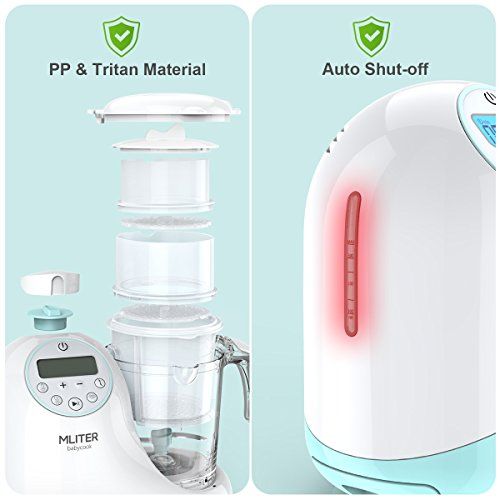 The compact design makes for easy storage, doesn't take up a lot of counter space, and the extra BPA-free containers are very helpful when it comes to putting away the food you just made.
The compact design makes for easy storage, doesn't take up a lot of counter space, and the extra BPA-free containers are very helpful when it comes to putting away the food you just made.
Using it is very simple: you put the blender bowl on the power base, press down, and it blends. It’s fairly easy to clean and blends quickly. The purees from the Nutribullet certainly weren’t bad, but they weren’t very consistent: some were perfectly smooth, while others had some chunks of food in them, especially at the bottom under the blades due to the shape of the bowl. It holds a decent amount of food, the manual and recipe book were very helpful, and the containers made it easy to pack everything up.
Qooc 4-in-1 Mini Baby Food Maker
At first glance, the QOOC 4-in-1 Food Maker is remarkably similar to the Beaba Babycook, and that’s actually not an incorrect way to describe it. Compact and featuring a stylish, minimalist design, the QOOC shares many of the same features as the Beaba (for about $20 cheaper). It steams and purees in minutes, and works with just one button. It comes with a separate tiny “pitcher” to measure out the amount of water you need.
One of the best things about this one is that the water reservoir has a large opening that not only makes it easy to see inside, but also makes it easier to clean. The instructions were a bit confusing, though: for example, while the food guide inside says to steam fruits for 15 minutes, the button on the front shows that you should steam fruits for 20 minutes. It left me feeling slightly lost on what to do, so I just guessed. Still, the QOOC makes impressively smooth purees. Although, in some cases, they were actually a little soup-like, which wasn’t exactly what I was going for.
With some great features and its small size, the QOOC is a great model, as long as you’re okay with figuring out steam times on your own.
Baby Brezza Glass One Step Baby Food Maker
Featuring a large glass bowl, the Baby Brezza One Step Glass Food Maker is clearly one of the more sturdy and durable options on the market. It’s a bit on the heavier side, but is still pretty compact for the size of the bowl, and has little suction cups on the bottom so that it won’t budge on the counter.
It’s a bit on the heavier side, but is still pretty compact for the size of the bowl, and has little suction cups on the bottom so that it won’t budge on the counter.
Perhaps the best selling feature of the Baby Brezza is its Steam&Blend option, which allows you to add your food and press one button, then walk away while it seamlessly goes from steaming to blending. I was the most excited about this, but to be honest, was left disappointed: I found that a lot of the steamed water collected in the bowl with the food, so when it was blended, the puree was super watered down, sometimes (like with the blueberries) to the point where it was barely edible. You can choose not to use the Steam&Blend option (when I did this, purees were much better) and try carefully straining the excess liquid out of the food, but this is difficult without a steamer basket. Plus, that’s kind of the selling point of this, so it’s frustrating that it doesn’t work that well.
I also noticed that water was getting into some parts of the bowl that I couldn’t clean, no matter how hard I tried, and that made me worry about mold in the future. It was quite loud when blending, something I definitely wouldn’t do during naptime. Still, it’s worth pointing out that the digital interface is a really nice touch and it’s super intuitive to use.
It was quite loud when blending, something I definitely wouldn’t do during naptime. Still, it’s worth pointing out that the digital interface is a really nice touch and it’s super intuitive to use.
Pros
-
Durable
-
Easy to use
-
Digital interface
Sage Spoonfuls Sage Baby Puree and Blend
The Sage Spoonfuls Sage Baby Puree and Blend stands out: it’s a stainless-steel immersion blender that comes with a batch bowl. It doesn’t steam food and is more of a hands-on option since you have to hold the immersion blender down. So, if you were thinking of making food while also holding your baby, you probably wouldn’t be able to accomplish that with this option.
There are still plenty of pros, though: the immersion blender worked just as well as the other blenders on this list in making smooth purees, if not better in some cases. Since it’s not a system at all, it’s smaller and easier to store, and doesn’t have to sit out on your counter. It’s easy to clean because there are so few pieces. It’s also very versatile: this is basically just an immersion blender, so you can use it for anything else, not just baby food. As for the cons? Aside from the fact that it requires two hands to use, the blender bowl is rather small and won’t hold too much food (although it’s worth noting you can use any bowl with this). Basically, there are no special features or add-ons to this one, it’s very straightforward.
Since it’s not a system at all, it’s smaller and easier to store, and doesn’t have to sit out on your counter. It’s easy to clean because there are so few pieces. It’s also very versatile: this is basically just an immersion blender, so you can use it for anything else, not just baby food. As for the cons? Aside from the fact that it requires two hands to use, the blender bowl is rather small and won’t hold too much food (although it’s worth noting you can use any bowl with this). Basically, there are no special features or add-ons to this one, it’s very straightforward.
What You Should Know About Baby Food Makers
Do you need a baby food maker?
Many new parents question whether they really need a baby food maker or not, and the answer truly depends on your lifestyle. If you know that you'll be making most, if not all, of your baby's food, then yes, a baby food maker may be worth investing in. If you know that you won't be making most of their food, then you might want to skip this purchase and opt for just using the blender or food processor you already own instead.
The benefits of a baby food maker
There are plenty of advantages to using a baby food maker. Making your own baby food can save you money in the long run, it can be the healthier option compared to some jarred baby foods, and it allows you to know exactly what is in your baby's food. Combination baby food makers that steam and blend your food make both cooking and cleaning easier and more convenient than using a separate blender and steamer.
What to look for when buying a baby food maker
A baby food maker should make cooking baby food more convenient, so look for a machine that is easy to clean, doesn't come with complicated instructions, and doesn't take up too much space in your kitchen. You should also read reviews and select the baby food maker that does the best job at quickly and effortlessly pureeing even the toughest foods out there.
How long you'll use it: You'll likely use a baby food maker once your baby is six months old and up until your baby is about 12-13 months old, at which point they'll probably stop eating purees.
More Articles You Might Enjoy
- The Best Breast Pumps
- The Best Bottle Drying Racks
- The Best Strollers
- The best baby food maker is an immersion blender
Meet the tester
Jessica Booth
Contributor
Jessica is a freelance writer from New York who loves to write about travel, beauty, parenting, and food. She has also written for sites such as Refinery 29, Bustle, Parents, Romper, The Daily Beast, Insider, and Redbook. She spend most of her spare time on Instagram or in the kitchen cooking.
See all of Jessica Booth's reviews
Checking our work.
Our team is here for one purpose: to help you buy the best stuff and love what you own. Our writers, editors, and lab technicians obsess over the products we cover to make sure you're confident and satisfied. Have a different opinion about something we recommend? Email us and we'll compare notes.
Shoot us an email
How to choose a baby food maker
Motherhood is much easier when there are helpers nearby. And they can be not only close people, but also equipment. Having at hand a couple of useful devices, you can save about an hour every day (plus or minus), which you can devote to yourself or your child.
Organization of nutrition for the baby is just the process that takes the most time. And it's great that it can be significantly simplified. Let's take a look at the different types of baby food and how to choose the right one. nineOl000 expressed milk, but the bottle must be sterile, and the food itself must be at body temperature (36-37 ° C). Many mothers heat milk the old-fashioned way - in a microwave oven or in a mug of hot water. But this process takes a lot of time, besides, you need to go to the kitchen, and it is unpleasant to do this at night. nine0003
Modern technology comes to the aid of mothers - bottle warmers and sterilizers.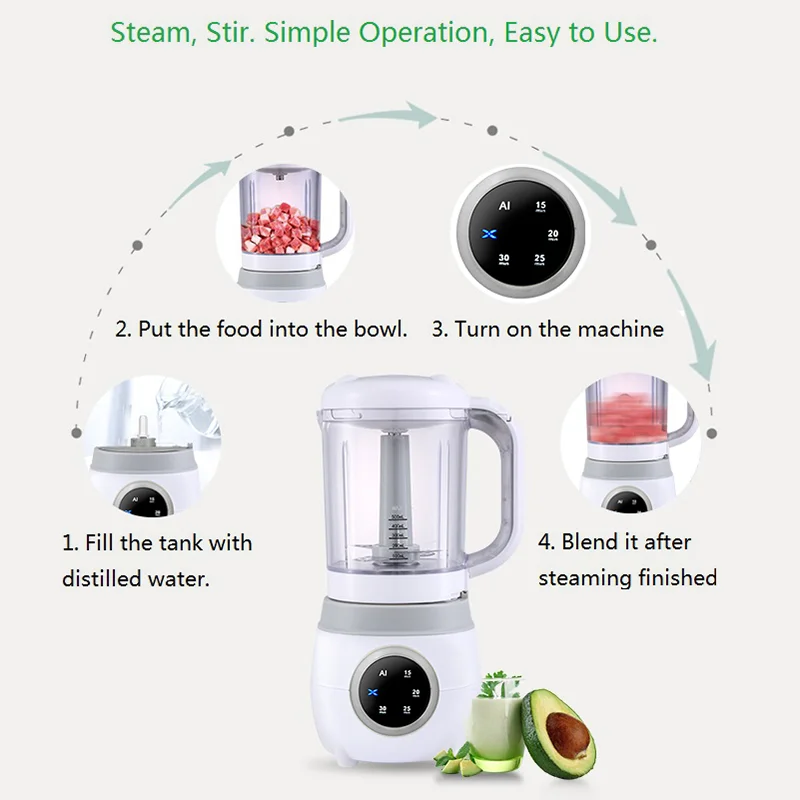 They can be placed in the room, so you don’t have to go far.
They can be placed in the room, so you don’t have to go far.
Consider the main types of heaters and sterilizers, and how to choose them correctly.
Bottle warmers
Bottle warmers are:
-
Steam: bottles are heated by hot steam. The device maintains the desired temperature, so the mixture does not overheat. Such models are not designed for a large number of bottles. nine0003
-
On hot water: the food will be heated by water at 80-90°C. Here you need to get the hang of it a little, because you can overheat the mixture, the bottles are hot and hot water drips from them.
-
On warm water (50-60°C). There are no risks here, but heating is slow.
-
Electric: the bottles are heated by a heating element. These are fast and convenient models. No need to mess with water, the device can be taken in a car or a trip. But the bottom of the mixture will be hotter than the top, so it needs to be shaken and checked for temperature.
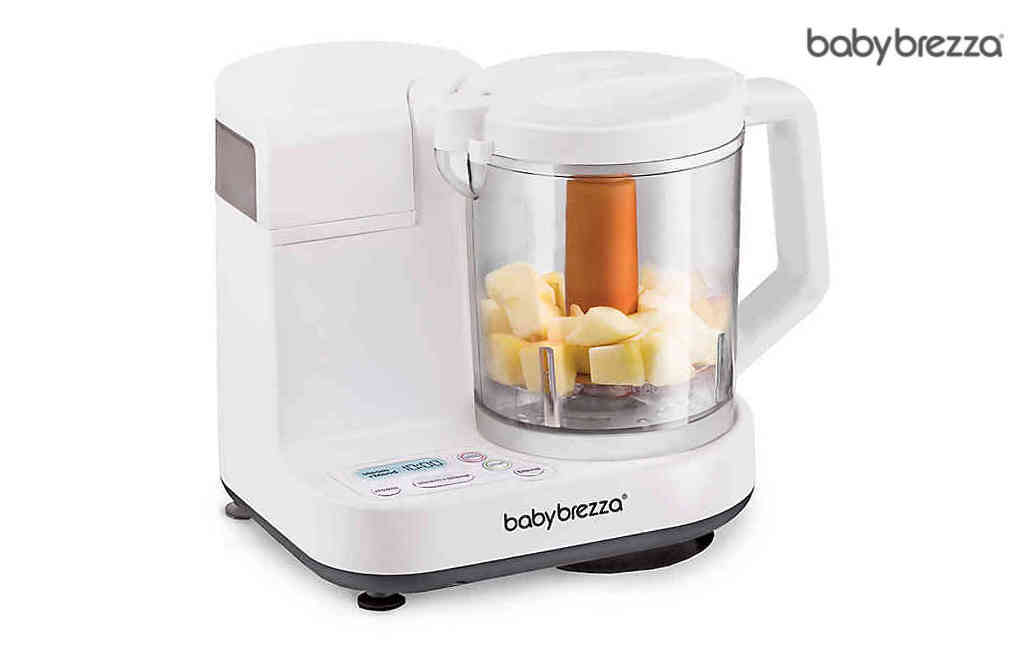 nine0003
nine0003
The choice of one or another type of heater depends on personal preferences for the convenience and speed of the process.
It is also important to pay attention to the number of bottles that the device can hold. If there are several of them, you will provide the baby with food for the whole night. Models with one bottle take up less space, but then there will be no supply of warm mixture.
It is very convenient to have a temperature maintenance mode. With it, the food will be at the right temperature for a couple of hours. You just need to get a bottle and give it to your baby. nine0003
Sterilizers
Sterilizers are also available in three varieties:
-
Steam: convenient models that allow you to process 6-8 bottles at a time, including metal ones.
-
For microwave ovens: the most affordable models. Processing also comes at the expense of steam (you need to pour water), only in the microwave.

-
Ultraviolet: sterilization is carried out by irradiation with an ultraviolet lamp. Only one bottle can be processed at a time, which is not very convenient. nine0003
Attention: it is impossible to sterilize in a microwave oven without a sterilizer. Bottles and nipples are easily damaged.
The processing time depends on the device type:
-
in the steam - 5-15 minutes;
-
in microwave sterilizers - up to 30 minutes;
-
in ultraviolet - 5 minutes.
When choosing the right model, it is important to pay attention to the number of bottles that the device will process at a time. nine0003
It will not be superfluous to pay attention to the auto-off function. It will turn off the device at the end of the treatment or if the water runs out.
There are also combined devices - sterilizers-heaters. Their capacity is small (up to 2 bottles), but even such a small device will greatly simplify the care of the baby.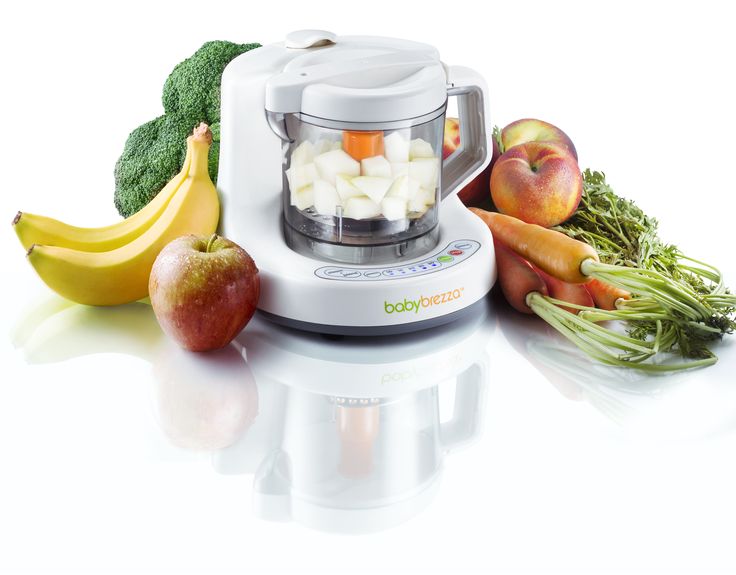
Useful tools for mothers of babies to feed
Babies under 1.5 years old need very small portions of food. Someone feeds the child from a portioned jar, while someone prefers to cook on their own. To simplify this process, the blender-steamer comes to the rescue .
This is a combined instrument. It consists of a compartment with water and a bowl with knives. First you need to cut the vegetables, turn on the steamer mode and wait for the end of cooking. Then switch the lever to blender mode and grind them. The whole process takes no more than 20 minutes.
With a steamer blender, food preparation takes much less time than with a conventional steamer or slow cooker. In one bowl, food is chopped and cooked, so there is less washing up. In addition, it is more convenient to cook small portions in such a device, and not in traditional ways. nine0003
In the steamer blender, you can cook all kinds of steamed dishes, with or without pre-grinding.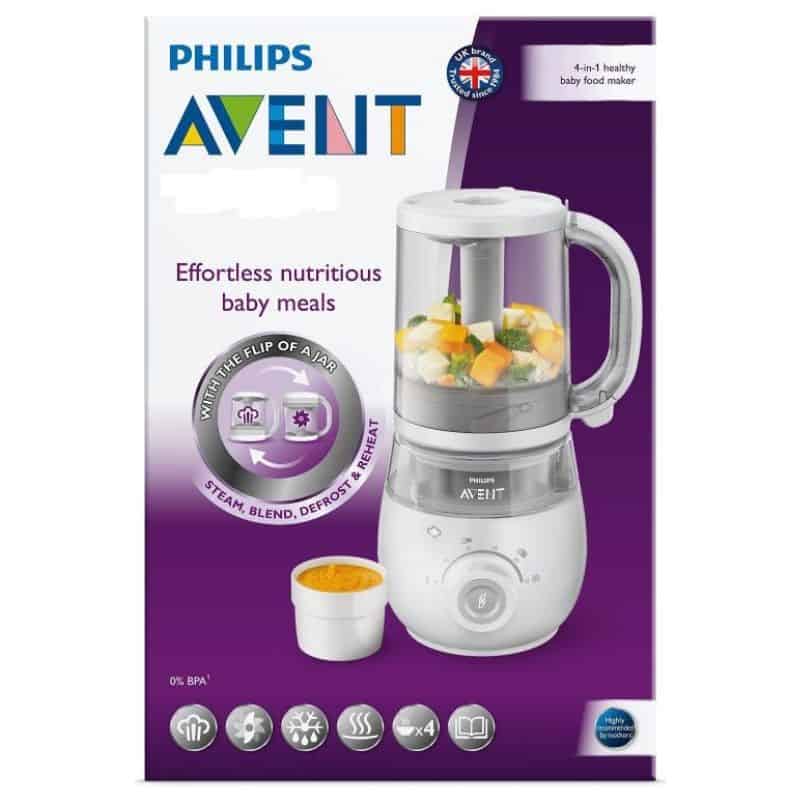
When choosing a device, pay attention to its power. The higher it is, the faster the water will boil. Suitable values are 400-500 watts.
In chopping, power does not play a special role, since sinewy meat will not be used for children, and any model will cope with vegetables and turkey.
When the baby is 7-8 months old, he can be given yogurt. Store-bought options are of little use due to more sugar and starch. To prepare healthy fermented milk products (yogurt, kefir, cottage cheese), you can purchase a separate yogurt maker. This device is budget-friendly, does not take up much space, and its benefits are huge. nine0003
Grown up children can be pampered with natural homemade ice cream, which is more convenient to prepare in an ice cream maker. The device constantly stirs the contents, and the ice cream is tender, which cannot be achieved with a mixer.
As you can see, manufacturers have taken care to facilitate the work of mothers.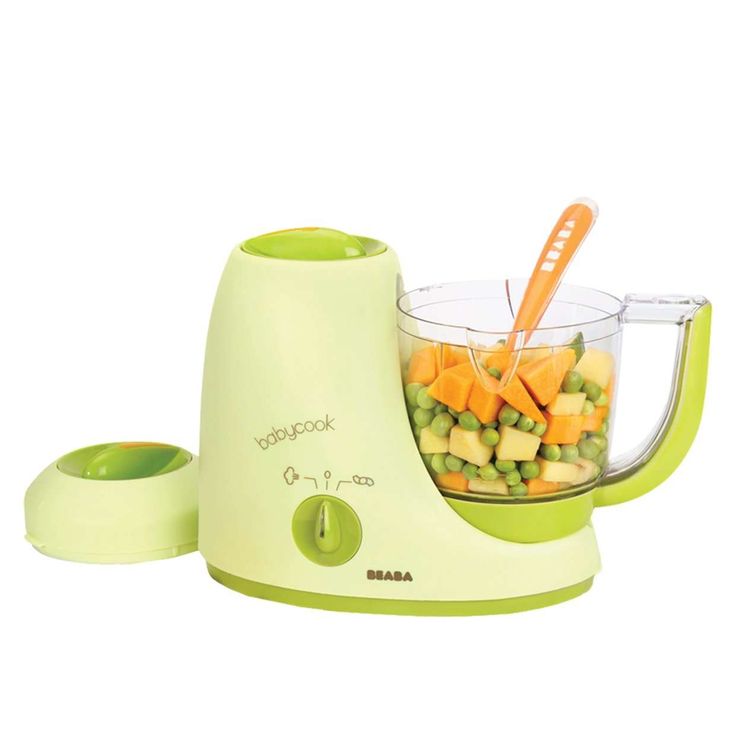 Assign routine duties to the technician, and enjoy communication with your children, because they grow up so fast!
Assign routine duties to the technician, and enjoy communication with your children, because they grow up so fast!
01/27/2020
Infant formula temperature: what temperature should infant formula be?
09/23/2019 Reading time: 5 min 117313 nine0003
Contents of the article
- Basic rules for preparing the mixture
- Separately about water
- Auxiliaries
- How to measure the mixture temperature?
- How to give formula?
- How to choose the right mix
- Expert advice
- Myths about infant formula
Basic formula preparation
nine0002 Mother's milk is the best food for a newborn. However, lactation does not occur in all women, and sometimes there is too little milk. In this case, infant formula comes to the rescue - a special food created taking into account all the needs of your baby. What temperature should be the infant formula and how to achieve ideal performance, we will tell in this article.
However, lactation does not occur in all women, and sometimes there is too little milk. In this case, infant formula comes to the rescue - a special food created taking into account all the needs of your baby. What temperature should be the infant formula and how to achieve ideal performance, we will tell in this article.
This is important!
The optimal and comfortable temperature of the mixture for the baby is 36-37 degrees Celsius, that is, the temperature of his body. nine0003
Some mothers, for ease of breeding, pour the mixture literally with boiling water. And this is a big mistake, because too hot water destroys the nutrients in baby food. Boiling water can be used, but only on the condition that it is diluted before you pour it into the infant formula.
Separately about water
When choosing water, pay attention to its labeling. Bottled has the designation "for food" or "for the preparation of mixtures." The second option does not contain a large amount of mineral salts, so it does not disturb the balance of the mixture.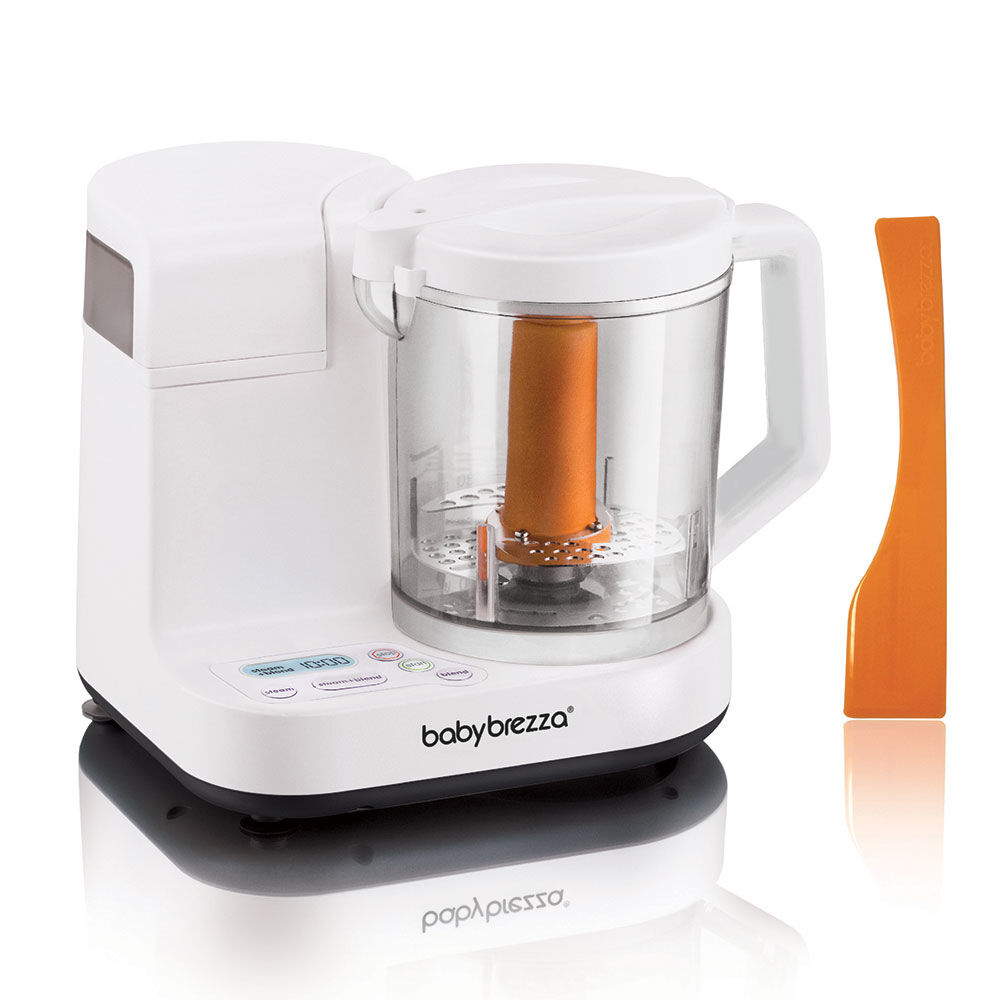 Moreover, it is recommended to use filtered and boiled tap water only in the most extreme cases. If you do not have the opportunity to regularly buy bottled water, purchase a special "children's" filter. It does an excellent job of purifying running water, making it more or less suitable for baby food. nine0010
Moreover, it is recommended to use filtered and boiled tap water only in the most extreme cases. If you do not have the opportunity to regularly buy bottled water, purchase a special "children's" filter. It does an excellent job of purifying running water, making it more or less suitable for baby food. nine0010
Auxiliaries
In the age of digital solutions and smart technology, any household issues, including maintaining the optimal water temperature for diluting the mixture, are solved with the help of assistant devices. Purchase an electric kettle with a built-in thermometer or a heater that allows you to maintain a constant optimum temperature around the clock - so you will always have “ready” water for cooking at hand.
How to measure mixture temperature? nine0183
There are several ways to measure. You can, as described above, use a kettle or heater with a predetermined temperature. It's fast and convenient. Breeding the mixture in the classical way, it is necessary to measure its temperature before giving it to the baby. For this you can use:
For this you can use:
• special thermometers for liquids;
• infrared thermometers;
• own wrist. Apply a few drops of nutrition to the back of the most delicate and sensitive part of the wrist. If it's hot for you, it will be hot for the baby; nine0003
• the area of the temples. It is also a sensitive and therefore "test" zone. Attach the bottle to the right or left temple - it should not burn the skin, you should feel a light and comfortable warmth.
Never try to determine the temperature of the mixture by taking a sip from the bottle or dipping your finger into it.
Both in the mouth and on the hands there are always a lot of bacteria, they can be potentially dangerous for the health of the child - do not risk it! nine0003
If the mixture is too cold or hot?
If the mixture is too hot, it is recommended to wait a bit with feeding, it will cool down at room temperature in 10-15 minutes.
If this worries the baby, you can cool the food by placing the bottle in a bowl of cold water.
If the food is cold, proceed in the same way, only by changing the temperature: place the mixture in a bowl of warm water. Do not use a microwave for this, food warms up unevenly in it, and there is a big risk for the baby to get burned. After cooling or heating, the temperature of the mixture must be checked before giving it to the child. nine0003
How to formulate?
In addition to strictly following the instructions for storing and diluting baby food, it must be given to the baby correctly.
This is important!
If the baby is mixed-fed due to a lack of mother's milk, it is necessary to supplement it with a mixture only after breastfeeding. The second option is to completely replace one feeding with formula*.
Baby food is served to the baby in a bottle that is convenient for him (watch the material of the nipple and the size of the hole: if it is too small, the child simply will not be able to eat, and if it is too large, he may choke).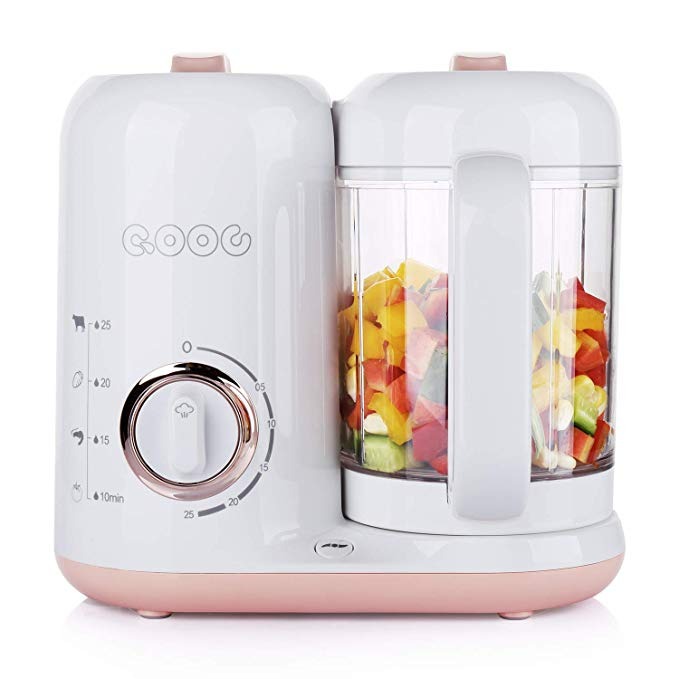 Before feeding, the bottle must be sterilized: you can use a pot of boiling water, a special sterilizer or a dishwasher for this. nine0003
Before feeding, the bottle must be sterilized: you can use a pot of boiling water, a special sterilizer or a dishwasher for this. nine0003
Another important note: if the child is completely bottle-fed, or the baby is sick (especially if there is a high temperature or diarrhea), it must be supplemented. The amount of liquid for supplementation during the day corresponds to the volume of one feeding. To do this, choose special baby water, which can be bought at a specialized store, a dedicated department of a supermarket or a pharmacy. Bottled water is also suitable for making infant formula. All questions about the drinking regimen of a baby on artificial or mixed feeding must be checked with a pediatrician! nine0003
How to choose the right mix
There are many varieties of infant formula available on the market. Conventionally, they can be divided into three main options:
- Dry, in powder form to be diluted with water.
- Liquid, prepackaged in sterile packaging, ready for use.

Regardless of the type of mixture, before feeding the baby, it must be brought to the desired temperature. This can be done with water (in the case of dry options) or simply by heating the package in a water bath (in the case of the finished mixture). It is recommended to choose your option with a pediatrician. However, it must be understood that regurgitation, infantile colic and constipation in most cases are associated with the age-related characteristics of the developing gastrointestinal tract and can sometimes increase with a change in diet or the introduction of new products. nine0010
Expert advice
However, according to the recommendations of doctors, the main thing in choosing an adapted mixture is its tolerance. This primarily means the absence of allergic reactions, as well as serious dyspeptic manifestations: regurgitation and vomiting, loose stools or constipation. Most modern adapted milk formulas contain all the necessary nutrients and vitamins:
• protein; nine0003
• fatty acids, including polyunsaturated ones;
• prebiotics and probiotics;
• biologically active components, including the carotenoid lutein contained in breast milk.